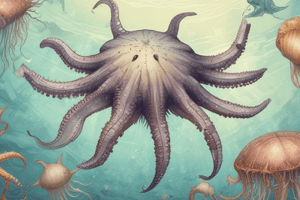Podcast
Questions and Answers
Explain the physiological adaptations and acclimations of a dolphin's flipper, as depicted in Figure 5.4.
Explain the physiological adaptations and acclimations of a dolphin's flipper, as depicted in Figure 5.4.
The pattern of veins (blue) wrapped around arteries in the flipper of a dolphin facilitates heat exchange, allowing the dolphin to regulate its body temperature in cold water by conserving heat and preventing excessive heat loss.
What are some environmental variables that can shift in the ocean, and what are the different time frames of these shifts?
What are some environmental variables that can shift in the ocean, and what are the different time frames of these shifts?
Some environmental variables that can shift in the ocean include temperature, salinity, oxygen, and light availability. These shifts can occur over decadal, annual, seasonal, and sub-daily time frames.
What could be a potential explanation for the bright red coloration of a galatheid crab on a sponge?
What could be a potential explanation for the bright red coloration of a galatheid crab on a sponge?
The bright red coloration of the galatheid crab may serve as a form of camouflage, helping it blend in with the surrounding sponge and providing protection from predators.
Can you provide a reason for the existence and placement of photophores in certain marine organisms?
Can you provide a reason for the existence and placement of photophores in certain marine organisms?
How do depth and light variation in the ocean impact the distribution and behavior of marine organisms?
How do depth and light variation in the ocean impact the distribution and behavior of marine organisms?
Flashcards are hidden until you start studying




